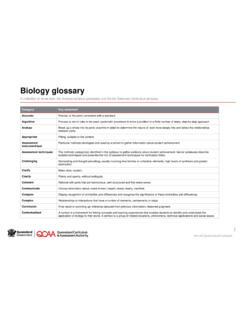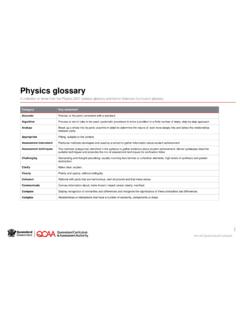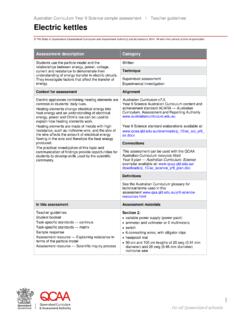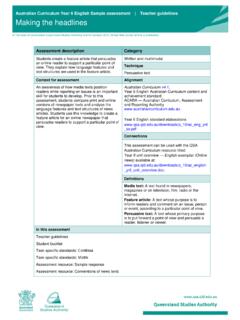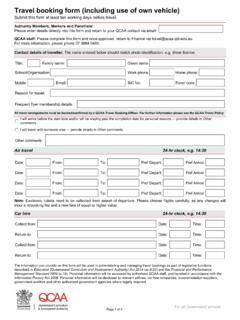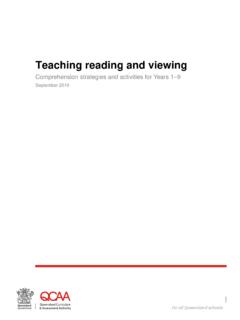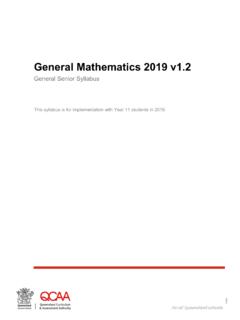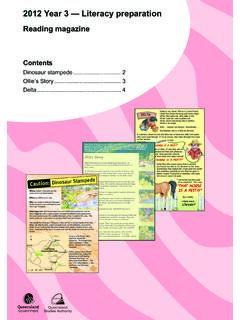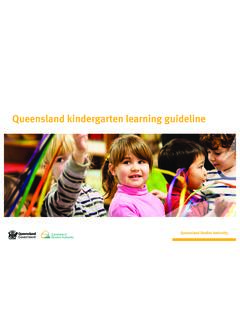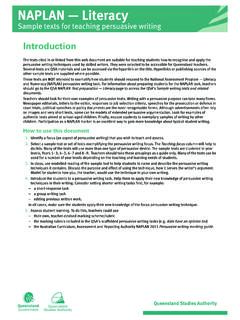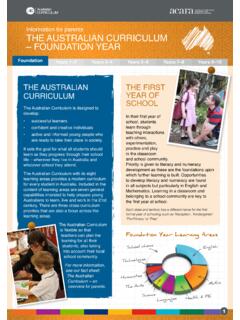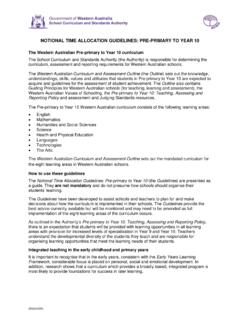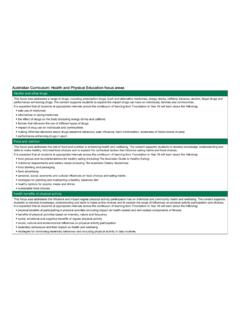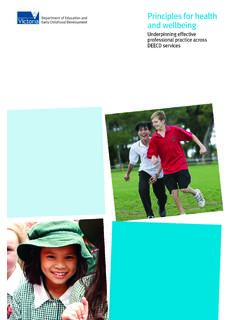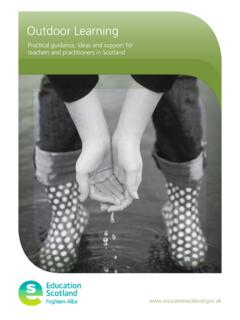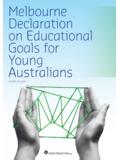Transcription of Throwing and catching - Queensland Curriculum and ...
1 The State of Queensland (The Office of the Queensland School Curriculum Council) 2000 health AND physical EDUCATIONLOWER PRIMARYL evelYEARS 1 TO 10 SOURCEBOOK MODULEHEALTH AND physical EDUCATIONF123456 B62 Throwing and catchingStrandDeveloping Concepts and Skills for physical ActivityPurposeStudents develop an understanding of the basic principles of Throwing andcatching, and demonstrate these skills in simple combinations. They note howthese skills require varying amounts of energy that cause physical changes tothe body and identify the opportunities that exist for participation inthrowing and catching activities in the local of activitiesActivities in this module are based on a learner-centred approach with anemphasis on decision making and problem solving.
2 As the following diagramshows, activities are sequenced in introductory, developing and : Throwing and catchingDeveloping: Processing informationCulminating: Applying skills and knowledge2 Throwing AND catching LOWER PRIMARY SOURCEBOOK MODULE health AND physical education The State of Queensland (The Office of the Queensland School Curriculum Council) 2000 Core learning outcomesThis module focuses on the following core learning outcomes from theYears 1 to 10 health and physical education Students demonstrate basic movement skills using equipment in play andsimple Students compare the effects on the body of participating in physicalactivities of varying contentThis module incorporates the following core content from the syllabus: components of movement, in particular body awareness and spaceawareness; principles of movement.
3 Skills acquisition; relationship between health , physical activity and strategyThe following are examples of assessment tasks that provide opportunities forstudents to demonstrate the core learning outcomes identified in thismodule. Students perform basic Throwing and catching skills over a shortdistance, using a variety of equipment. Can the student throw balls/beanbags over a short distance usingunderarm, overarm, one-handed, two-handed, overhead techniques? Can the student use appropriate body movements to catch balls/beanbags correctly? Students identify and describe the effects on the body of participating invarious physical activities of varying intensities. Can the student describe how the body changes when a person puts alot of effort into physical activity?
4 Can the student compare the effects on the body of those throwingand catching games and sports that require considerable effort andintensity with those that do not? Can the student vary the intensity of his or her participation inphysical activity?DevelopingConcepts and Skillsfor physical ActivityDevelopingConcepts and Skillsfor physical ActivityDevelopingConcepts and Skillsfor physical and Skillsfor physical AND catching LOWER PRIMARY SOURCEBOOK MODULE health AND physical education The State of Queensland (The Office of the Queensland School Curriculum Council) 2000 Background informationThrowing and catching skillsThrowing and catching skills are an important component of many gamesand activities played by students in the lower primary school.
5 It is importantthat students in the early years of schooling be given many opportunities todevelop these skills to prepare them for the games and sports they may playin the middle and upper primary years of school. Netball, softball, newcomb,football, basketball and cricket are some of the games that require good skillsin Throwing and module provides an introduction to a variety of Throwing and catchingskills and activities that can be developed further in later teaching andlearning. For students who are vision or hearing impaired, balls and beanbagsshould be large, brightly coloured and have bells inside local cricket, netball, basketball, softball and baseball associations forfurther advice on the skills and techniques of Throwing and approachThis module uses the multiple intelligence theory of Gardner (1983).
6 Multiple intelligence theory is based on the notion that people make sense oftheir world in a variety of ways using different intelligences. To date, Gardnerhas identified eight different intelligences verbal/linguistic, bodily/kinaesthetic, visual/spatial, logical/mathematical, musical/rhythmic,interpersonal/social, intrapersonal/introspective, and naturalist. All eightintelligences are present in each individual; thus, individuals needopportunities to develop those intelligences. Each individual also hasstrengths and weaknesses in particular intelligences, which further supportthe need for a focus on developing skills and knowledge across allintelligences. (For further detail on Gardner s theory see Resource Sheet 1, The multiple intelligences.)
7 The bodily/kinaesthetic intelligence underpins most activities in this moduleand therefore is also used as an integrating device with the other intelligences where appropriate. Despite the formal separation ofintelligences within this module, the activities associated with eachintelligence often integrate naturally with other intelligences. It is notnecessary to complete all activities from the module but teachers shouldensure that those activities selected provide opportunities for students todemonstrate the appropriate learning ResourceSheet 14 Throwing AND catching LOWER PRIMARY SOURCEBOOK MODULE health AND physical education The State of Queensland (The Office of the Queensland School Curriculum Council) 2000 TerminologyActivities in this module involve the use of the following language in thecontext of health and physical education .
8 Accuracyeffortstancebalancefieldthrowcat chheighttrackdemonstrateintensitytransfe r of weightdirectionmovementdistancereceiveSc hool authority policiesTeachers need to be aware of and observe school authority policies that maybe relevant to this policies are of particular relevance in this module. Some safety issuesthat teachers should consider are: providing adequate warm-up and cool-down exercises prior to andfollowing lessons; having students throw in the same direction during drill activities to avoidpossible injury; encouraging students to be sun justice principlesThis module provides opportunities for students to increase theirunderstanding and appreciation of supportive environments and includes activities that encourage students and teachers to: consider the needs of all students when demonstrating and planningthrowing and catching activities.
9 Modify the environment to ensure all students can engage in throwingand catching activities in a supportive with disabilities or learning difficulties may require some activitiesto be modified to optimise both their participation and their ability todemonstrate the outcomes. Teachers should consult with parents/carers andspecialist support staff to determine whether modification is AND catching LOWER PRIMARY SOURCEBOOK MODULE health AND physical education The State of Queensland (The Office of the Queensland School Curriculum Council) 2000 Support materials and referencesAustralian Sports Commission 1994, Sport It! Towards 2000: Teacher ResourceManual, Tactical Directions Pty Ltd, , J. 1997, Active Learning Handbook for the Multiple IntelligencesClassroom, Hawker Brownlow education , , A.
10 L. 1991, The search for intelligent life , in A. Costa (ed.),Developing Minds: A Resource Book for Teaching Thinking, vol. 1, Associationfor Supervision and Curriculum Development, Alexandria, , R. 1997, Problem-based Learning and Other Curriculum Models forthe Multiple Intelligences Classroom, Hawker Brownlow education , , R. & Bellanca, J. 1989, Patterns for Thinking: Patterns for Transfer,IRI/Skylight Publishing, Palatine, , R. & Stoehr, J. 1995, Integrating Curricula with MultipleIntelligences: Teams, Themes and Threads, Hawker Brownlow education , , H. 1983, Frames of Mind: The Theory of Multiple Intelligences,Harper Collins Publishers, New AND catching LOWER PRIMARY SOURCEBOOK MODULE health AND physical education The State of Queensland (The Office of the Queensland School Curriculum Council) 2000 ActivitiesGetting startedHave students throw and catch medium-sized balls in small groups toascertain their skills and abilities.
